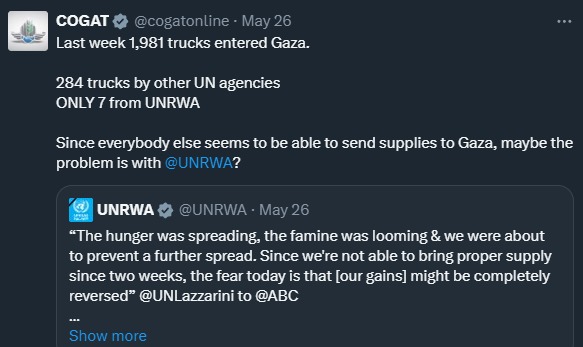The New York Times published an article, "Access to Aid in Gaza Was Dire. Now, It’s Worse," claiming that the number of trucks entering Gaza has been reduced since May 7 when the IDF took over the Rafah crossing. But COGAT has been reporting that on the contrary, more trucks of goods are entering Gaza.
Here is the Times' graphic:
The differences are huge:
(May 24 figure comes from the difference between COGAT's numbers for the entire week week and the total of the daily reports.)
If you believe the New York Times, the number of trucks never went above the minimum number needed for Gaza. If you believe COGAT, that number has been exceeded most days recently.
The NYT gave this methodology:
Daily truck counts were compiled from multiple sources, including the U.N. dashboard for southern border crossings, meeting minutes from the inter-agency Logistics Cluster, World Food Program reports and updates from COGAT, the Israeli military agency coordinating aid delivery. The counts were cross-checked with multi-date aid truck totals from the U.N. Office for the Coordination of Humanitarian Affairs and the Office of the Spokesperson for U.N. Secretary-General.Daily averages were calculated for the northern crossings from May 12 to May 15, as only a total count for that span of dates was available. Trucks carrying commercial goods are excluded.
That bolded sentence may account for some of the differences, but COGAT sometimes breaks down the categories of imports, and it still doesn't add up. On May 20, COGAT said that it facilitated 376 food trucks alone, and 27 more of water. A similar number wa brought in on May 22. Either there is a huge commercial business of importing food, or something else is going on.
It appears that the answer is buried in the latest UN OCHA-OPT report:
These figures do not include commercial trucks, as the UN has been unable to observe the arrival of private sector cargo through Kerem Shalom crossing due to insecurity. Supplies that are dropped off at the crossing without safety or logistical viability for humanitarian organizations to pick them up are also not included in these statistics.
This explains it. Israel is bringing in plenty of aid, but the aid organizations are not taking them from the crossings to the people.
This makes sense - because COGAT has been begging the aid agencies to work with them, saying that they want to coordinate with any and all aid agencies but they - especially UNRWA - are the ones not cooperating!
Now, why didn't the New York Times mention this? Clearly they are aware of COGAT's statistics, and they know how many actual trucks are entering Gaza. Yet their infographic makes it appear that the aid trucks are not entering Gaza at all.
I could understand if the Times reports on the specific dispute and shows both sets of numbers. But this is all it says, way down the article:
COGAT, the Israeli military agency coordinating aid delivery, has said that increasing the amount of aid going into Gaza remains a priority. It reports daily that it has inspected hundreds of trucks and coordinated their transfer to border crossings, though the figures are often higher than those reported by aid organizations, which track the number of trucks that have collected goods for entry into Gaza and exclude trucks carrying commercial goods.
Neither set of figures accounts for difficulties in distribution that can prevent aid from getting to Gazan civilians. Israel says enough aid is entering Gaza and has blamed aid groups for not distributing it faster to civilians — a characterization the aid groups dispute, saying Israeli forces have made distribution extremely difficult.
By not reporting on the hundreds of trucks being brought into Gaza daily and waiting to be picked up, the New York Times is effectively saying that Israel is not trustworthy. Their claims of hundreds of trucks being brought into Gaza are not even worth counting. Even though it makes no sense for COGAT to go to so much effort to bring in aid and not want to see it distributed, the Times accepts the aid agencies' claims and does not even try to find out the truth.
Beyond that, the commercial goods that no one wants to count are a story in themselves that also contradict the narrative of things getting worse for Gazans since Israel took over the Rafah crossing. This Gaza journalist says that prices in the markets that had been sky high beforehand have gone down dramatically since Israel now controls all imports into Gaza. He says the high prices were the result of Egypt and Hamas controlling the border crossing. If the shortages are getting worse, how can the food be getting cheaper? It is another story the New York Times doesn't want to cover. (h/t Abu Ali Express)
I cannot say for sure that COGAT is not at fault for aid distribution delays. I do not have the information of what is happening between the trucks entering and the aid being distributed, and I do not know details about the commercial imports. But this is exactly what the New York Times should be doing - and it instead already decides who is right and doesn't bother to report on the other side, except perfunctorily.
The idea that Israel is just dumping aid trucks at the crossings and doesn't care what happens afterwards, which is what the aid agencies and the NYT are pretty much saying, is not much better than a blood libel.
|
Or order from your favorite bookseller, using ISBN 9798985708424. Read all about it here! |

|









